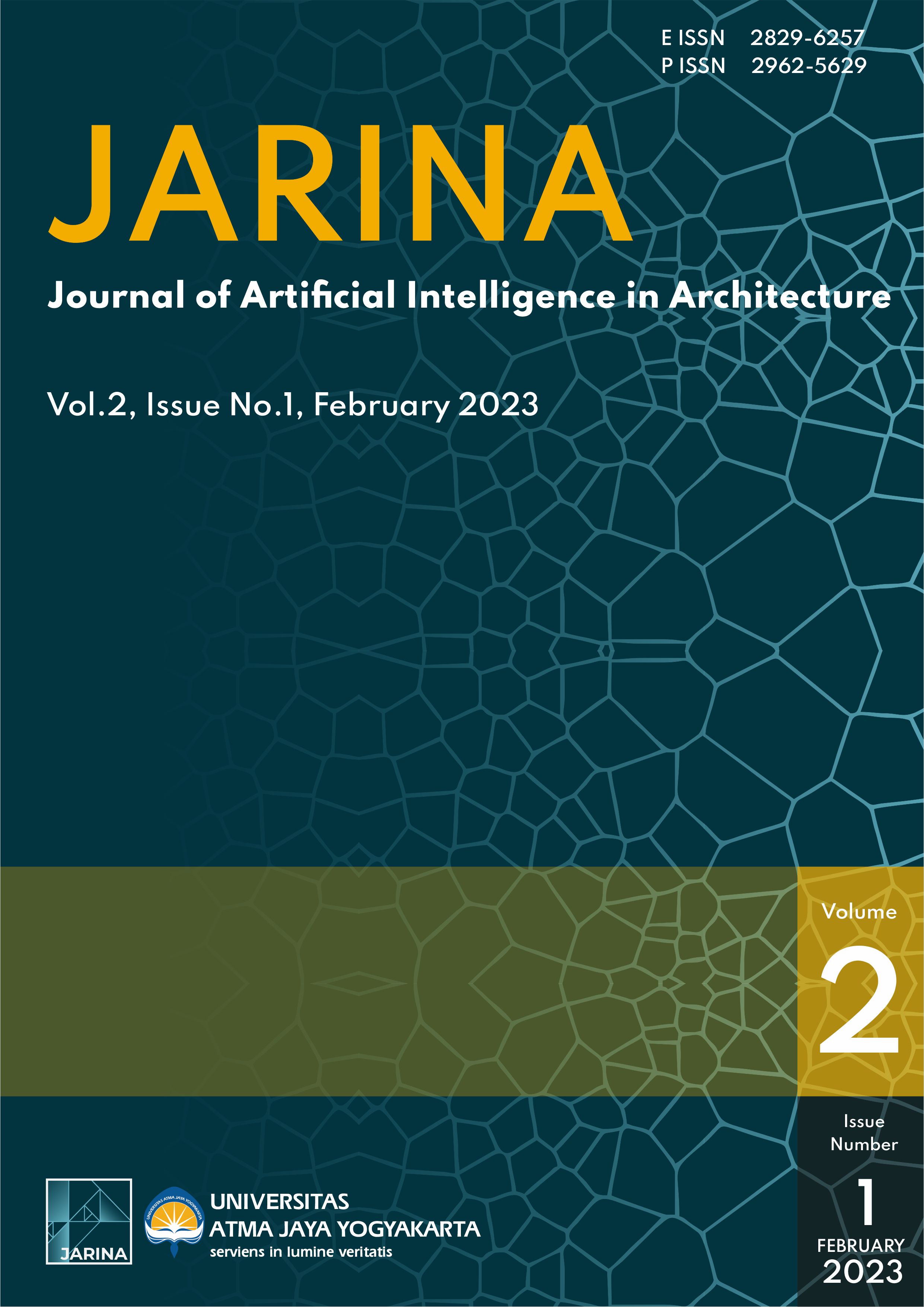From Artificial Intelligence to Artificial Consciousness: An Interior Design Implication
DOI:
https://doi.org/10.24002/jarina.v2i1.6627Keywords:
Artificial Intelligence, Interior Design, Artificial Consciousness, Humanoid RobotAbstract
Artificial Intelligence continues to develop rapidly and provokes people to think about Artificial consciousness. Anthropocentric understanding considers consciousness a unique feature of human beings not possessed by other living beings. However, software and hardware development demonstrated the ability to process, analyze, and infer increasingly comprehensive data close to the image of human brain performance. Furthermore, the application of artificial Intelligence to human-friendly objects that can communicate with humans evokes the presence of consciousness within these objects. This paper discusses the presence of artificial consciousness in humanoid robots as an evolutionary continuation of artificial Intelligence. It estimates its implications for architecture, primarily within interior design. Consciousness has a special place in architecture, as it guides Intelligence in engineering and brings it to an abstract level, such as aesthetics. This paper extracts popular information from Internet conversations and theories in pre-existing scientific journals. This paper concludes that the adaptability of both parties and the balance of positions between the two parties in the future will influence the development of interior design approaches that will integrate artificial Intelligence and humans.
References
R. Kurzweil, “The Singularity Is Near : When Humans Transcend Biology.” Penguin, 2005.
“Transhumanism, Elevating the Human Condition? | Santander Global Tech.” https://santandergto.com/en/transhumanism-elevating-human-condition/ (accessed Nov. 30, 2022).
“Pets Are Critical For Older Adults.”
Jacqueline Howard, “Robot pets: Can they comfort us like the real thing? - CNN.” https://edition.cnn.com/2016/10/03/health/robot-pets-loneliness/index.html (accessed Nov. 30, 2022).
R. Booth, “Robots to be used in UK care homes to help reduce loneliness | Social care | The Guardian.” https://www.theguardian.com/society/2020/sep/07/robots-used-uk-care-homes-help-reduce-loneliness (accessed Dec. 01, 2022).
S. Natale and A. Ballatore, “Imagining the thinking machine: Technological myths and the rise of artificial intelligence,” Convergence, 2020, doi: 10.1177/1354856517715164.
D. Gamez, “The Relationships Between Intelligence and Consciousness in Natural and Artificial Systems,” J. Artif. Intell. Conscious., 2020, doi: 10.1142/s2705078520300017.
G. W. Ng and W. C. Leung, “Strong Artificial Intelligence and Consciousness,” J. Artif. Intell. Conscious., vol. 07, no. 01, pp. 63–72, Mar. 2020, doi: 10.1142/S2705078520300042.
P. O. A. Haikonen, “On Artificial Intelligence and Consciousness,” J. Artif. Intell. Conscious., vol. 07, no. 01, pp. 73–82, Mar. 2020, doi: 10.1142/S2705078520500046.
J. A. Reggia, G. E. Katz, and G. P. Davis, “Artificial Conscious Intelligence,” J. Artif. Intell. Conscious., vol. 07, no. 01, pp. 95–107, Mar. 2020, doi: 10.1142/S270507852050006X.
I. Aleksander, “The Category of Machines that Become Conscious,” J. Artif. Intell. Conscious., vol. 07, no. 01, pp. 3–13, Mar. 2020, doi: 10.1142/S2705078520300029.
A. Churches, “Bloom’s Taxonomy blooms digitally,” Tech Learn., vol. 196605124, pp. 1–6, 2008, [Online]. Available: http://www.techlearning.com/showArticle.php?articleID=196605124
I. As, S. Pal, and P. Basu, “Artificial intelligence in architecture: Generating conceptual design via deep learning,” Int. J. Archit. Comput., vol. 16, no. 4, pp. 306–327, Dec. 2018, doi: 10.1177/1478077118800982/ASSET/IMAGES/LARGE/10.1177_1478077118800982-FIG2.JPEG.
D. McNary, “‘Alita: Battle Angel’ New Trailer Debuts at Comic-Con - Variety.” https://variety.com/2018/film/news/alita-battle-angel-trailer-james-cameron-robert-rodriguez-1202880975/ (accessed Dec. 01, 2022).
T. J. Prescott and J. M. Robillard, “Are friends electric? The benefits and risks of human-robot relationships,” iScience, vol. 24, no. 1, Jan. 2021, doi: 10.1016/j.isci.2020.101993.
T. Kishi et al., “Development of expressive robotic head for bipedal humanoid robot,” in IEEE International Conference on Intelligent Robots and Systems, 2012. doi: 10.1109/IROS.2012.6386050.
Z. Yu, G. Ma, and Q. Huang, “Modeling and design of a humanoid robotic face based on an active drive points model,” Adv. Robot., 2014, doi: 10.1080/01691864.2013.867290.
I. Asher Hamilton, “People are kicking Starship Technologies’ food delivery robots,” 09.06.2018, 2018. https://www.businessinsider.de/people-are-kicking-starship-technologies-food-delivery-robots-2018-6?r=US&IR=T (accessed Nov. 10, 2022).
J. Lynn, “Why Do I Want to Kick Those Cute Little Food-Delivery Robots? | by Jessica Lynn | The Bold Italic,” 2022. https://thebolditalic.com/why-do-i-want-to-kick-those-cute-little-food-delivery-robots-ba0555a144d9 (accessed Nov. 10, 2022).
E. S. Cross and R. Ramsey, “Mind Meets Machine: Towards a Cognitive Science of Human–Machine Interactions,” Trends in Cognitive Sciences. 2021. doi: 10.1016/j.tics.2020.11.009.
B. Wessling, “Kiwibot brings in $7.5 million in Pre-Series A funding - The Robot Report.” https://www.therobotreport.com/kiwibot-brings-in-7-5-million-in-pre-series-a-funding/ (accessed Dec. 01, 2022).
A. Bhaumik, From AI to Robotics. 2018. doi: 10.1201/9781315372549.
S. Shamsuddin et al., “Humanoid robot NAO: Review of control and motion exploration,” in Proceedings - 2011 IEEE International Conference on Control System, Computing and Engineering, ICCSCE 2011, 2011. doi: 10.1109/ICCSCE.2011.6190579.
“Why are lonely Asians turning to robots for friendship? | South China Morning Post.”
S. Shigemi, “ASIMO and Humanoid Robot Research at Honda,” in Humanoid Robotics: A Reference, 2019. doi: 10.1007/978-94-007-6046-2_9.
K. S. Saladin, Human anatomy, 4th ed. New York: McGraw Hill, 2014.
N. Palastanga and R. Soames, Anatomy and Human Movement Structure and Function, 6th ed. Elsevier, 2012.
R. Behnke, Kinetic Anatomy. Human Kinetics, 2005.
S. Saeedvand, M. Jafari, H. S. Aghdasi, and J. Baltes, “A comprehensive survey on humanoid robot development,” Knowledge Engineering Review. 2019. doi: 10.1017/S0269888919000158.
H. Ding, Z. Shi, Y. Hu, J. Li, B. Yu, and P. Zhang, “Lightweight design optimization for legs of bipedal humanoid robot,” Struct. Multidiscip. Optim., 2021, doi: 10.1007/s00158-021-02968-2.
K. Hashimoto, Y. Yoshimura, H. Kondo, H. O. Lim, and A. Takanishi, “Realization of quick turn of biped humanoid robot by using slipping motion with both feet,” in Proceedings - IEEE International Conference on Robotics and Automation, 2011. doi: 10.1109/ICRA.2011.5980498.
G. Z. Yang et al., “The grand challenges of science robotics,” Science Robotics. 2018. doi: 10.1126/scirobotics.aar7650.
H. Bennett, “Cyborgs: Inside the technology transcending biological limits | BBC Science Focus Magazine.” https://www.sciencefocus.com/future-technology/cyborgs-transhumans/ (accessed Nov. 14, 2022).
A. Agrawal, A. N. Dube, D. Kansara, S. Shah, and S. Sheth, “Exoskeleton: The Friend of Mankind in context of Rehabilitation and Enhancement,” Indian J. Sci. Technol., vol. 9, no. S1, pp. 1–8, 2016, doi: 10.17485/ijst/2016/v9is1/100889.
J. C. Lennox, “2084: Artificial intelligence and the future of humanity.” Zondervan, 2020.
R. R. Murphy and A. Texas, “Beyond Asimov : The Three Laws of Responsible Robotics,” IEEE Intell. Syst., vol. 24, no. 4, pp. 14–20, 2009.
K. Darling, “The New Breed.” Henry Holt and Co, New York, 2021.
M. Novak, “Watching Television With My Robot Butler (1932) — Paleofuture.” https://paleofuture.com/blog/2011/1/28/watching-television-with-my-robot-butler-1932.html (accessed Nov. 14, 2022).
“Designing the Next Generation Bridge — Forgotten Trek.” https://forgottentrek.com/the-next-generation/designing-the-next-generation-bridge/ (accessed Dec. 01, 2022).
J. A. A. Thompson and N. H. Blossom, Eds., The Handbook of Interior Design. Wiley Blackwell, 2015. doi: 10.1002/9781118532409.
É. Fourneret, “The Hybridization of the Human with Brain Implants: The Neuralink Project,” Cambridge Q. Healthc. Ethics, vol. 29, no. 4, pp. 668–672, 2020, doi: 10.1017/S0963180120000419.
A. B. Craig, Understanding Augmented Reality. Concepts and Applications. Elsevier Inc, 2013.
M. Mazzone and A. Elgammal, “Art, Creativity, and the Potential of Artificial Intelligence,” Arts, vol. 8, no. 1, p. 26, 2019, doi: 10.3390/arts8010026.
S. Dodsworth, The Fundamentals of Interior Design, vol. 20, no. 4. Singapore: AVA Publishing SA, 2009. doi: 10.1080/14606925.2017.1325635.

Downloads
Published
How to Cite
Issue
Section
License
Copyright (c) 2023 Trias Mahendarto

This work is licensed under a Creative Commons Attribution 4.0 International License.
Authors who publish with this journal agree to the following terms:
1.Authors retain copyright and grant the journal right of first publication with the work simultaneously licensed under a Creative Commons that allows others to share the work with an acknowledgement of the work's authorship and initial publication in this journal.
2.Authors are able to enter into separate, additional contractual arrangements for the non-exclusive distribution of the journal's published version of the work (e.g., post it to an institutional repository or publish it in a book), with an acknowledgement of its initial publication in this journal.
3.Authors are permitted and encouraged to post their work online (e.g., in institutional repositories or on their website) prior to and during the submission process, as it can lead to productive exchanges, as well as earlier and greater citation of published work (See The Effect of Open Access).
















